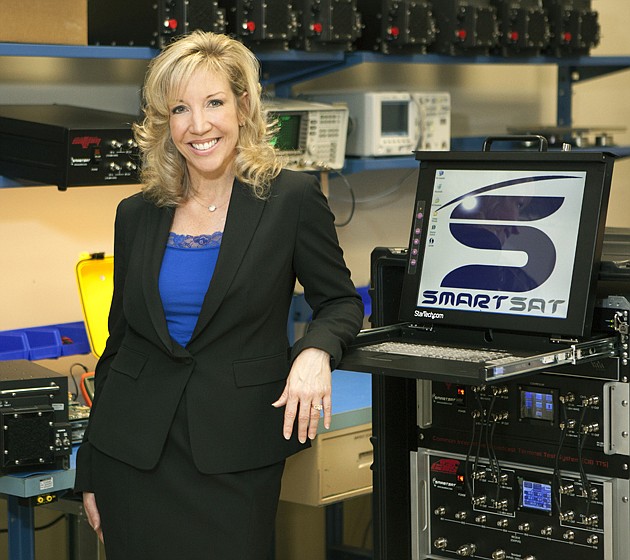- November 25, 2024
-
-
Loading

Loading

In 1995, while taking a break from work to care for her first son, Heidi Akers started to get fed up with chores like laundry, food, and nursing. Akers, who had been working in marketing and PR for Raytheon, says “I pretty much went from going 100 miles per hour to what felt like a dead stop.”
So it was perfect timing when Akers's former vice president from Raytheon stopped by her house with a business idea. Although she didn't have experience running a business, Akers decided to join the VP in building a satellite communications company, SmartSAT.
The two built their business working from a garage. They hired all retirees, because Akers could relate to their wanting to keep busy, and it was relatively low risk if they didn't have enough work.
They quickly sold their first technology idea to a company in Texas and realized they needed more help engineering. “In the technology world, if you can find one really good customer, then that becomes your launching point.” A year and a half after starting, they hired Aker's husband, David.
Since then, the company has grown to $5 million in annual revenues selling satellite simulators and amplifiers to governments and contractors. Two years ago, Akers and her husband bought out their partner. Now that Akers' kids are in their late teens, she and her husband are “ready to kick it in high gear.”
The company has found success by sticking to a niche in satellite communications. During the first Desert Storm, military operators realized it was a struggle to communicate with different military units if they weren't using radios that were compatible with each other. Hence, the military created a standard certification across all branches of service.
In wartime, satellites can't be used for testing. Realizing this, SmartSAT created satellite simulators. The simulators allow radio developers in the lab or out in the field to test the radio with the satellite and make sure it is working properly.
The company's big breakthrough came after participating in a government competition where the SmartSAT's satellite simulator ranked No. 1, and the company received a five-year contract. “All radio manufacturers, if they want to operate, they have to be certified via our satellite simulator,” Aker says.
The company's first government contract was with the Australian government. SmartSAT shipped more than 311 simulators to Australia, and now they're circling back to the company for upgrades. “You open them up and shake the sand out of them,” Akers says.
Because the simulator was selected as the common certification standard, the equipment was put in front of a number of prime contractors, who also wanted to purchase the equipment for testing. That way the contractor could test radios in their home labs to make sure they worked flawlessly before sending them to the test bed at Arizona's Fort Huachuca, where they are certified by the military.
Despite not being the cheapest simulator on the market, many contractors are willing to pay for an in-house simulator before paying for the military's certification testing. SmartSAT has sold hundreds of its simulators and other equipment to a number of government-contracting giants, including Lockheed Martin, Raytheon, and DRS Technologies.
It's been a tough year for government contracting with the mandatory furloughs, Akers admits, and contractors and businesses selling to contractors have felt the strain. SmartSAT is lucky to have long-term contracts, such as its five-year contract with the Air Force, to sustain it through tight times.
Nonetheless, Akers doesn't let defense budget cuts distract the company from innovating new technology. “As things change, you don't panic, and you look for the opportunity,” she says.
Demand for the company's products has remained relatively steady because it is constantly working to improve the simulators and amplifiers, adding touch screens or compacting equipment. If a large order comes in, SmartSAT works with local manufacturing companies in the Tampa area to create more printed circuit boards, accommodating for the flux in demand without growing too fast.
“We're a business that never likes to operate in debt,” Akers says. “We make the money and then we grow.” Akers believes it's a benefit of being in a high-tech niche industry. “Being in the niche area we are, we don't have to manufacture, pump out huge quantities of products in order to maintain our staff base and maintain our overhead.”
Akers says keeping her staff employed is her No. 1 priority. Maintaining a flexible work environment is a close second. “Many business people may say, 'Boy, is she naïve.' But our definition of success is not year-over-year increase of profit, it's if we can keep everyone employed.” She also wants to provide her staff the same opportunities she's been given throughout her career — to spend valuable time with family. “I'm not willing to sacrifice all of the other intangibles to make money.”
INNOVATION
Leveraging the SmartSAT technology, Heidi and David Akers are helping their production manager branch into commercial products. The team's newest innovation are LED lights that can be programmed with any Android device to change colors with music or flow around a room. The small portable devices communicate to each other wirelessly to light up event spaces and restaurants. Their lights are currently being used at Nova 535, a restaurant in St. Petersburg. Branching into commercial products is a “new and scary area. After 18 years, I know the government arena,” Akers says. “But you have to innovate or die. It's important that we reach out in other directions.”